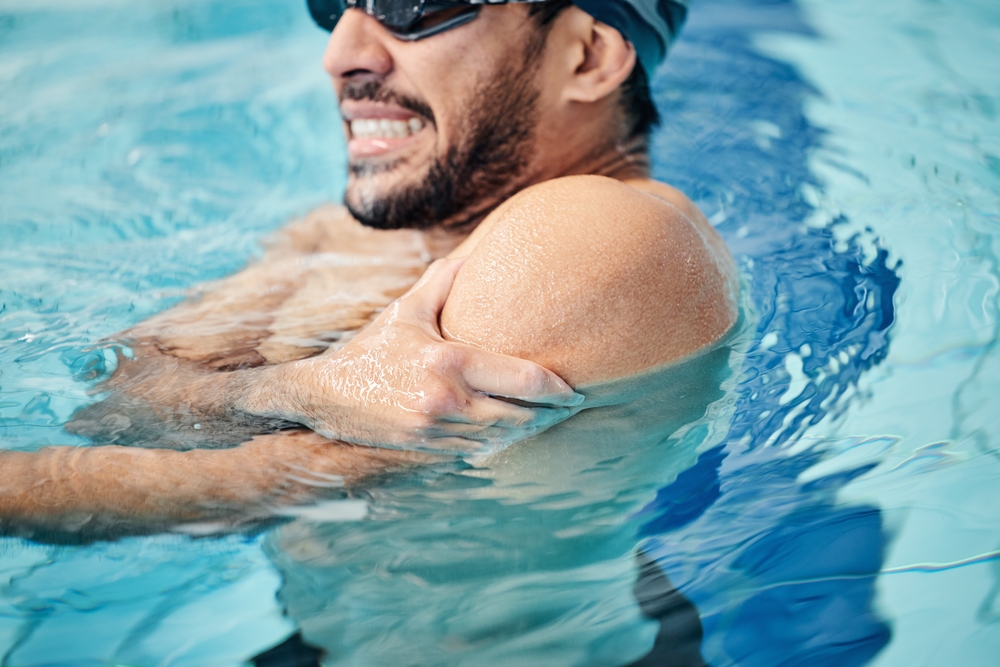Top 7 Shoulder Injuries in Sports: How to Prevent and Treat Them
Your shoulders work harder than you realize, especially if you’re involved in sports that demand repetitive arm movements or high-impact actions. Whether you’re swinging a racket, throwing a ball, or tackling opponents, your shoulders are at the center of it all.
This constant strain makes them highly susceptible to injuries, increasing the risk of overuse, strain, and impact-related damage over time.
Now, let’s break down the seven most common shoulder injuries in sports, how to prevent them, and what you can do to recover if they strike.
1. Rotator Cuff Tears
Rotator cuff tears are a top concern for athletes in overhead sports like tennis, swimming, and baseball. The repetitive motions these sports demand can strain the small muscles and tendons, stabilizing your shoulder.

How to Spot It: You’ll feel pain when lifting your arm or rotating your shoulder. Weakness and limited range of motion are common.
How to Prevent It: Incorporate strength training for your rotator cuff muscles into your routine. Combine this with flexibility exercises and a solid warm-up before games or practice.
How to Treat It: Start with rest, ice, and physical therapy. Severe cases might require surgery, but catching it early can often avoid invasive treatments.
2. Shoulder Dislocations
Contact sports like football and hockey increase the risk of shoulder dislocations. This injury happens when the upper arm bone pops out of the shoulder socket due to impact or overextension.
How to Spot It: You’ll notice intense pain, swelling, and often a visible deformity in your shoulder.
How to Prevent It: Strengthen the stabilizing muscles around your shoulder, and wear protective gear during high-impact activities.
How to Treat It: Seek immediate medical attention to reposition the joint. After that, follow up with rest, immobilization, and targeted physical therapy for athletes
3. Shoulder Impingement Syndrome
Athletes in volleyball, swimming, and basketball often encounter shoulder impingement syndrome, which happens when the shoulder blade pinches the tendons or bursa.
How to Spot It: Pain during lifting and reduced mobility are red flags.
How to Prevent It: Focus on posture correction during workouts and include exercises to strengthen your rotator cuff. Proper form during sports is non-negotiable.
How to Treat It: Rest, anti-inflammatory treatments, and physical therapy can restore comfort and movement.
4. SLAP Tears (Superior Labrum Anterior and Posterior)
Repeated overhead motions in sports like baseball or javelin throwing can lead to SLAP tears. This common shoulder injury involves damage to the cartilage around the socket of your shoulder joint.
How to Spot It: A popping or grinding sensation in your shoulder, paired with weakness and pain, might point to a SLAP tear.
How to Prevent It: Warm up thoroughly before every game or workout, and avoid overtraining. Include dynamic stretches and rotator cuff exercises to build resilience.
How to Treat It: Rest and rehabilitation are your first steps. If the tear is severe, surgical repair might be necessary.
5. Frozen Shoulder (Adhesive Capsulitis)
A frozen shoulder often develops when you don’t fully recover from another shoulder injury, leading to stiffness and restricted movement over time.
How to Spot It: Gradually increasing stiffness and limited range of motion are key signs.
How to Prevent It: Don’t skip your recovery process after an injury. Gentle mobility exercises can help keep your shoulder functioning while you heal.
How to Treat It: Stretching and physical therapy are essential. For severe cases, corticosteroid injections might be recommended to reduce inflammation.
6. Biceps Tendonitis
If you play golf, row, or participate in other sports requiring repetitive arm motions, you’re more likely to encounter biceps tendonitis.
How to Spot It: Look for tenderness in the front of your shoulder and a dull ache that worsens with activity.
How to Prevent It: Strengthen your shoulder and biceps muscles, and be mindful of overuse. Rest is crucial when you notice early signs of discomfort.
How to Treat It: Use ice to reduce inflammation and rest your arm. Gradual reintroduction of activity and physical therapy can help restore function.
7. Acromioclavicular (AC) Joint Injuries
A direct blow to the shoulder during rugby, cycling, or other high-impact sports can cause AC joint injuries.
How to Spot It: You’ll feel pain at the top of your shoulder, often accompanied by swelling or difficulty raising your arm.
How to Prevent It: Strengthen the muscles supporting your shoulder and wear padded gear for added protection in contact sports.
How to Treat It: Rest and bracing work well for mild cases. Severe injuries might need surgery, followed by rehabilitation to regain strength and mobility.
Tips for Preventing Shoulder Injuries
Consistency in prevention is key. Build a balanced training regimen that includes strength, mobility, and flexibility exercises. Focus on form and technique during practices, and invest in proper gear that supports your shoulder health.

Most importantly, listen to your body. Taking rest days and allowing time for recovery can be game-changers in avoiding injuries.
When to Seek Professional Help
If you experience persistent pain, swelling, or restricted motion in your shoulder, don’t push through it. Consult a professional to assess your injury. Early intervention can prevent minor issues from becoming major setbacks.
Prioritizing your shoulder health ensures you can stay active and perform at your best without risking long-term damage.
Final Thoughts
Shoulder injuries can be a frustrating hurdle for athletes, but understanding how to prevent and treat them is the first step in staying injury-free.
By addressing the most common shoulder injuries in sports with the right techniques and recovery practices, you’ll keep your shoulders strong, mobile, and ready for action. Invest in your health, and you’ll enjoy a long, successful athletic career.
Schedule Your Consultation with Expert Manual Therapy
If you’re dealing with a shoulder injury or want to prevent one, we’re here to help. At Expert Manual Therapy, we specialize in personalized care to keep you performing at your best.
From injury prevention to post-injury recovery, we’ll design a treatment plan tailored to your needs.
Contact our manual therapy clinic in Austin today and take the first step toward healthier, stronger shoulders!

